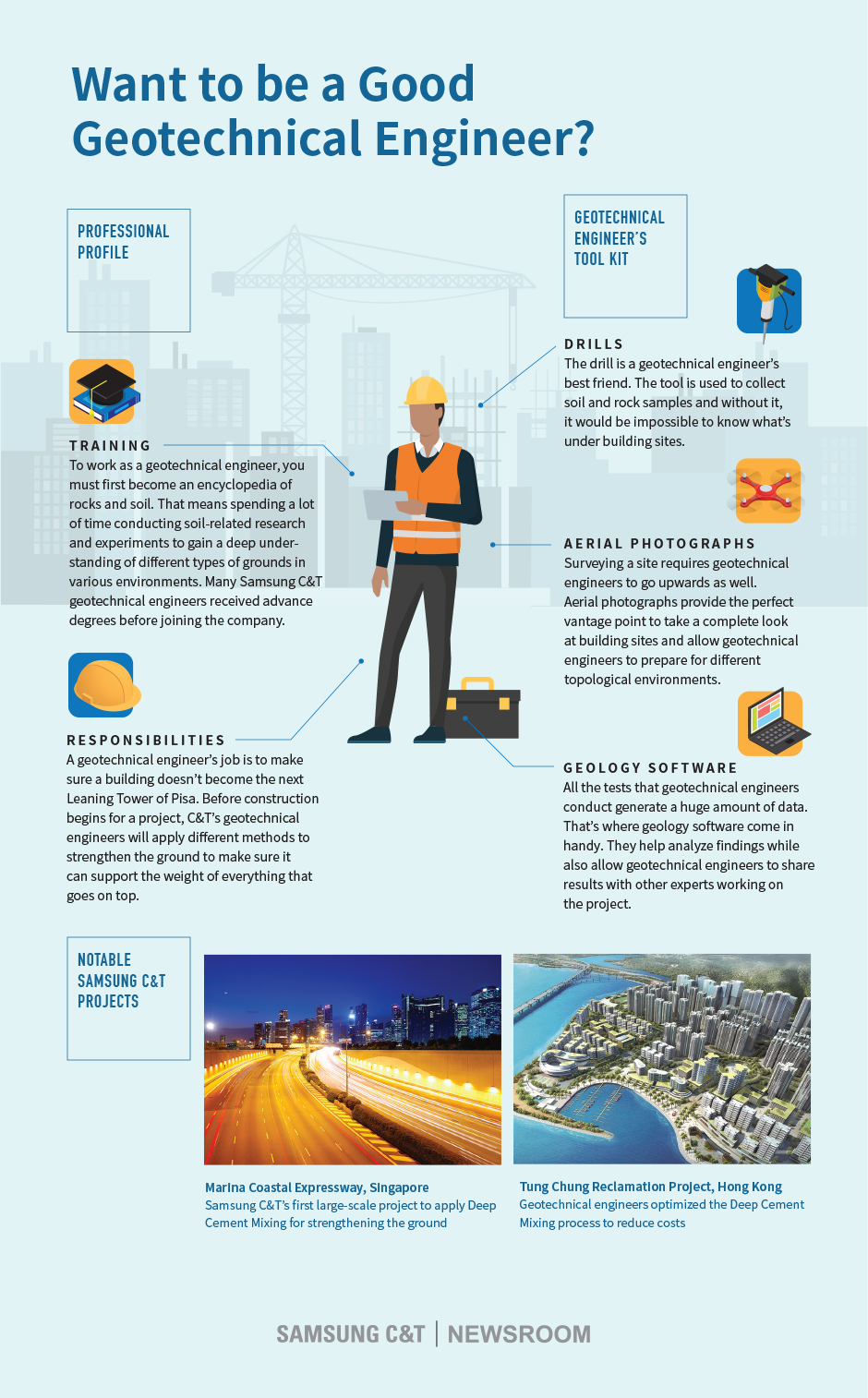Some Of Geotheta
Table of ContentsFacts About Geotheta RevealedNot known Facts About GeothetaRumored Buzz on GeothetaExcitement About GeothetaThe Basic Principles Of Geotheta

They perform website examinations, gather samples, execute laboratory tests, and analyze information to examine the suitability of the ground for building tasks - Tailings Engineer. Based upon their searchings for, geotechnical designers supply referrals for foundation style, incline stability, keeping frameworks, and mitigation of geotechnical dangers. They collaborate with various other experts, such as architects, structural designers, and construction teams, to guarantee that geotechnical factors to consider are integrated right into the general job design and application
By evaluating the behavior and residential properties of soil and rock, they can determine potential geotechnical hazards such as landslides, soil settlement, or incline instability. Their proficiency assists protect against failings or accidents that might endanger lives and residential property. Here are some thorough duties and obligations of a geotechnical engineer: Site Examination: Geotechnical engineers conduct site investigations to gather information on subsurface problems.
They interpret the information to comprehend the residential or commercial properties and actions of the dirt and rock, including their toughness, leaks in the structure, compaction characteristics, and groundwater problems. Geotechnical Analysis and Layout: Geotechnical engineers assess the data accumulated throughout site examinations to assess the stability and suitability of the website for building tasks. They do geotechnical calculations and modeling to assess aspects such as bearing ability, settlement, incline security, lateral earth pressures, and groundwater circulation.
7 Simple Techniques For Geotheta
Foundation Style: Geotechnical engineers play an important role in creating foundations that can safely support the intended framework. They examine the soil conditions and lots demands to establish the appropriate foundation kind, such as superficial foundations (e.g., grounds), deep structures (e.g (https://www.imdb.com/user/ur185987626/?ref_=nv_usr_prof_2)., piles), or specialized methods like soil enhancement. They take into consideration aspects such as negotiation limits, bearing capability, and soil-structure communication to create ideal structure styles
They evaluate construction plans, monitor website activities, and carry out field assessments to verify that the design referrals are adhered to. If unanticipated geotechnical problems arise, they evaluate the scenario and offer suggestions for removal or adjustments to the layout. Threat Analysis and Mitigation: Geotechnical engineers evaluate geotechnical dangers and threats connected with the job website, such as landslides, liquefaction, or soil disintegration.

Partnership and Communication: Geotechnical designers work very closely with various other professionals associated with a job, such as architects, architectural designers, and building and construction groups. Efficient communication and cooperation are vital to incorporate geotechnical considerations right into the total task design and building and construction process. Geotechnical designers supply technical knowledge, solution inquiries, and guarantee that geotechnical needs are fulfilled.
About Geotheta
Right here are some sorts of geotechnical designers: Foundation Engineer: Foundation engineers focus on developing and examining structures for structures. They analyze the soil problems, load requirements, and website characteristics to identify the most ideal structure kind and design, such as superficial structures, deep structures, or specialized strategies like stack structures.
They assess the elements influencing slope stability, such as soil residential properties, groundwater conditions, and slope geometry, and develop approaches to avoid slope failures and reduce risks. Earthquake Designer: Quake designers focus on evaluating and making structures to withstand seismic forces. They assess the seismic hazard of a website, assess dirt liquefaction potential, and develop seismic layout criteria to make certain the safety and resilience of frameworks throughout quakes.
They execute field testing, collect examples, and evaluate the collected information to characterize the soil residential properties, geologic developments, and groundwater conditions at a site. Geotechnical Instrumentation Designer: Geotechnical instrumentation engineers focus on surveillance and measuring the behavior of soil, rock, and frameworks. They install and maintain instrumentation systems that keep an eye on elements such as soil settlement, groundwater levels, incline motions, and structural displacements to examine efficiency and give very early cautions of possible concerns.
Geotheta Can Be Fun For Everyone
They carry out tests such as triaxial tests, loan consolidation tests, direct shear tests, and leaks in the structure examinations to collect information for geotechnical analysis and design. Geosynthetics Engineer: Geosynthetics engineers concentrate on the style and application of geosynthetic materials, such as geotextiles, geogrids, and geomembranes. They make use of these products to enhance dirt security, strengthen slopes, supply water drainage remedies, and control disintegration.
They tend to be investigatory have a peek at this website people, which indicates they're intellectual, reflective, and analytical. They are curious, methodical, sensible, analytical, and logical. Some of them are additionally social, suggesting they're kind, generous, participating, client, caring, handy, compassionate, skillful, and pleasant - Engineer of Record.
In the workplace setting, geotechnical engineers utilize specialized software program devices to carry out calculations, create designs, and examine data. They prepare records, evaluation job specifications, connect with clients and staff member, and coordinate project tasks. The office setup supplies a helpful atmosphere for study, analysis, and collaboration with various other specialists associated with the job.
The 6-Minute Rule for Geotheta
They regularly see task sites to perform website examinations, evaluate geotechnical problems, and collect information for evaluation. These visits include traveling to different areas, occasionally in remote or difficult surfaces. Geotechnical designers might execute soil sampling, conduct tests, and display building and construction tasks to make sure that the geotechnical aspects of the job are being implemented properly.
Geotechnical designers likewise operate in specialized geotechnical research laboratories. In these facilities, they perform experiments, do tests on dirt and rock samples, and assess the engineering homes of the products. Geotechnical lab designers work thoroughly in these environments, handling screening equipment, operating instruments, and taping information. They collaborate with various other laboratory team to make certain accurate and trustworthy screening results.